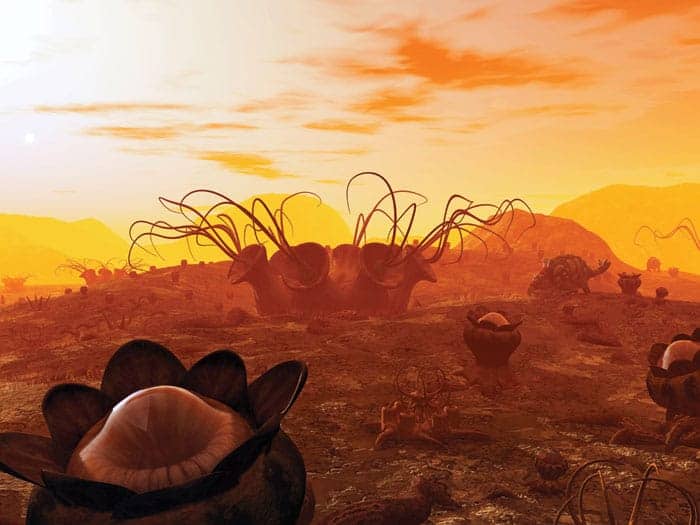Is there a microbe army rising on the Moon? In this article (originally published in Lateral Thoughts, Physics World’s regular column of humorous and offbeat essays, puzzles, crosswords, quizzes and comics, which appears on the back page of the print edition), ESA astrobiologist Nicol Caplin ponders the pitfalls of planetary protection, and sending biological samples to the Moon

News emerged over the summer that the Israeli SpaceIL Beresheet lander – which crashed onto the lunar surface in April this year – was unknowingly carrying a payload full of reportedly indestructible biological samples. This consignment, known as the Lunar Library, was created by the Arch Mission Foundation – an organization whose goal is to project the culmination of human knowledge out to space but also, perhaps more bleakly, to provide a backup plan for if humanity goes under.
The package included a nanodisc containing a 30-million-page archive of human history, as well as a batch of biological specimens, including DNA extracted from human hair and red blood cells. Also on board, embedded within multiple layers of metal and specially slow-cured resin, was one of Earth’s most extreme survivors.
Tardigrades – also known as water bears – are hardy creatures that are ubiquitous in our environment. They are classed as “extremophiles” – organisms that exist in physically or geochemically extreme conditions that are detrimental to most other lifeforms on Earth. Frequenting mosses and lichens, these microscopic animals can survive extreme temperatures, pressures, radiation and even outright desiccation by entering a dormant state.
In 2007 an experiment led by Ingemar Jönsson of Kristianstad University, Sweden, and colleagues in Germany, saw a batch of desiccated tardigrades spend 12 days in orbit, aboard a free-flying capsule known as FOTON-M3. When the retrieved samples were analysed in the laboratory, it was found that the tardigrades survived the space vacuum very well. However, samples that were also exposed to some types of ultraviolet (UV) radiation didn’t have the same success, and samples that were exposed to vacuum and the whole gamut of UV wavelengths from solar light had an extremely poor tolerance. Of the three individual tardigrades that survived this exposure, none lived past a week.
The Beresheet tardigrades were in an inactive state, with a dramatically reduced metabolism. If they survived the initial lunar collision, it is important to note that the only way they can be reactivated is with water. Even if the smashed-open samples were ever exposed to water (perhaps if an icy comet collided with the impact site), they almost certainly wouldn’t survive without protection from harmful UV rays. Lastly, if they did, there’s no food up there to sustain them anyway.
While there is no threat of the tardigrades on the Moon rising up and attacking Earth, the saga has renewed interest in planetary protection discourse
So, while there is no threat of the tardigrades on the Moon rising up and attacking Earth, the saga has renewed interest in planetary protection discourse. The Committee on Space Research (COSPAR) has devised several categories for space missions, each increasing in complexity. The Moon is labelled as a “category II” destination (significant interest relative to the process of chemical evolution and the origin of life, but where there is only a remote chance that contamination carried by a spacecraft could compromise future investigations). This is a higher protection level compared to the concern-free base “category I”, but it still doesn’t require extra measures aside from rudimentary paperwork explaining mission details.
Introducing the tardigrade samples was not in direct breach of any of this. However, the story would be very different for other locations where there might be life, or traces of ancient life. From an astrobiology perspective, depositing extremophiles onto the surface of Mars could completely skew our search for extant life. This is the reasoning behind COSPAR making Mars a Category III (and in some cases higher) destination. This category explicitly states that a region with this designation is of great interest for life-detection missions, where any contamination would compromise scientific efforts.
The dried riverbeds we see on Mars today hint at the possibility that life may have once existed on the planet. Once the European Space Agency’s ExoMars 2020 mission is under way, scientists will be able to robotically gather samples, from up to two metres under the surface, thanks to the rover’s large drill attachment. The excavated samples may contain fossils, or nothing at all. The important thing here is to avoid any contamination, and make sure that anything we send to Mars arrives at the destination in as sterile condition as possible.

Life as we do and don’t know it
Imagine if even a few tardigrades manage to stow away inside a shielded craft to Mars, and travelled directly to the Martian surface; or even worse, to the surface of the drill. We would end up with a scenario of “finding” tardigrades in the soil – a false positive result. This would be catastrophic for science teams working on the projects, as they could really be led to believe that life existed independently outside of Earth. Mars is far enough away that it would be virtually impossible for anyone to clean the instruments and perform a re-test. You might wonder why we couldn’t just build an autoclave into the rover for in situ sterilization. Aside from being a huge technical challenge, some of the hardiest extremophile spores can even withstand that. Radioactive sterilization is theoretically possible, although the risk of contaminating Mars from isotopic sources is also something to avoid when visiting our cosmic neighbours.
The most straightforward route is to continue performing cleanroom protocols for outbound spacecraft and do our very best to keep equipment squeaky clean before exposing it to other worlds. This is standard practice for regulation-compliant space agencies, but is it now time to introduce hard legislation for private entities sending biology out into the cosmos?



